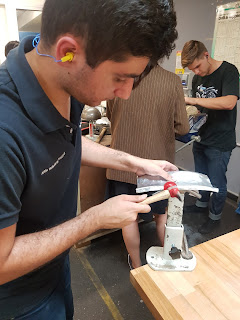The Tray

THE TRAY In this week’s lesson, we were being assessed on shaping and forming metal sheet into a small tray. Initially, we went with Martin, to mark out the template with the assistance of the laser cutting machine. This template allowed us to see which radius we would pursue i.e. the smaller the radius the harder shaping the sides and corner however the better the finish that is achieved. CNC Machine making Template of Radius Curving out the edges of the timber template on the sander After we had decided what radius we were going to attempt we got our two pieces of timber to make out templates. Once my partner and I had drawn our template on both pieces of timber, we went to the sander to carve out our template on piece of timber. Once we had our template of both pieces of timber, we had to shape our timber. Marking out template on Metal Sheet In shaping our timber, we initially were going to use t...

